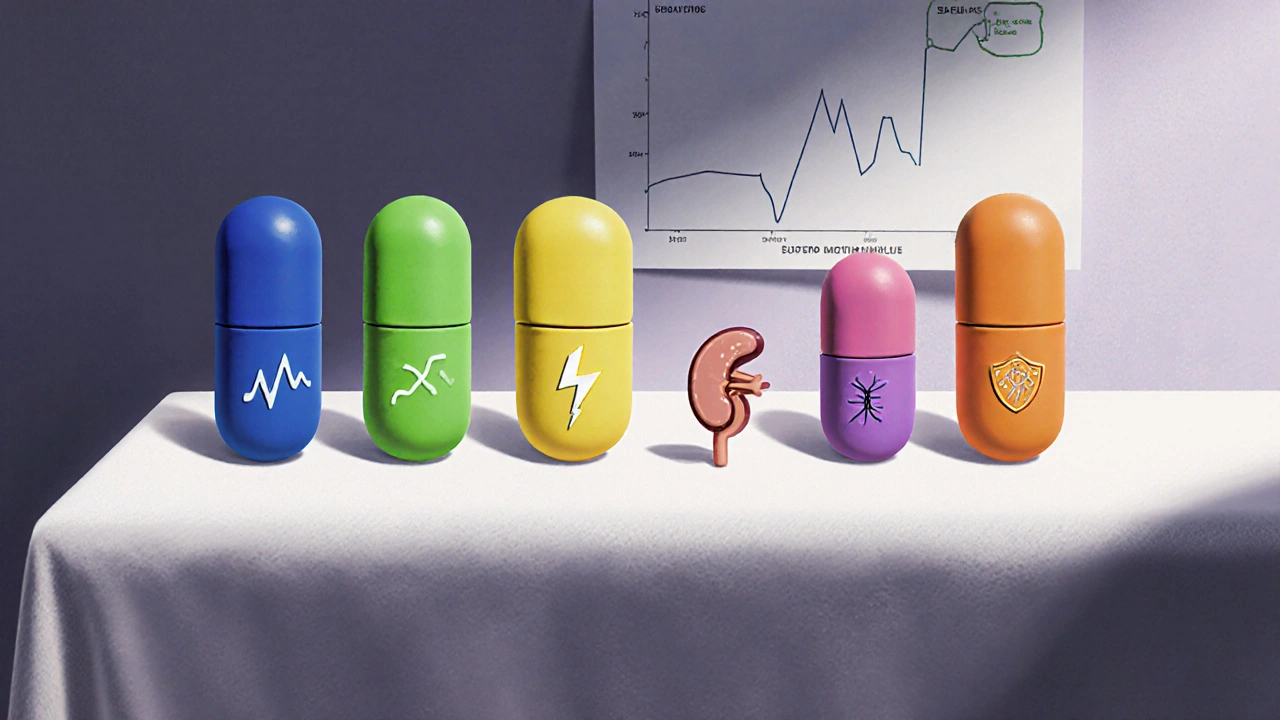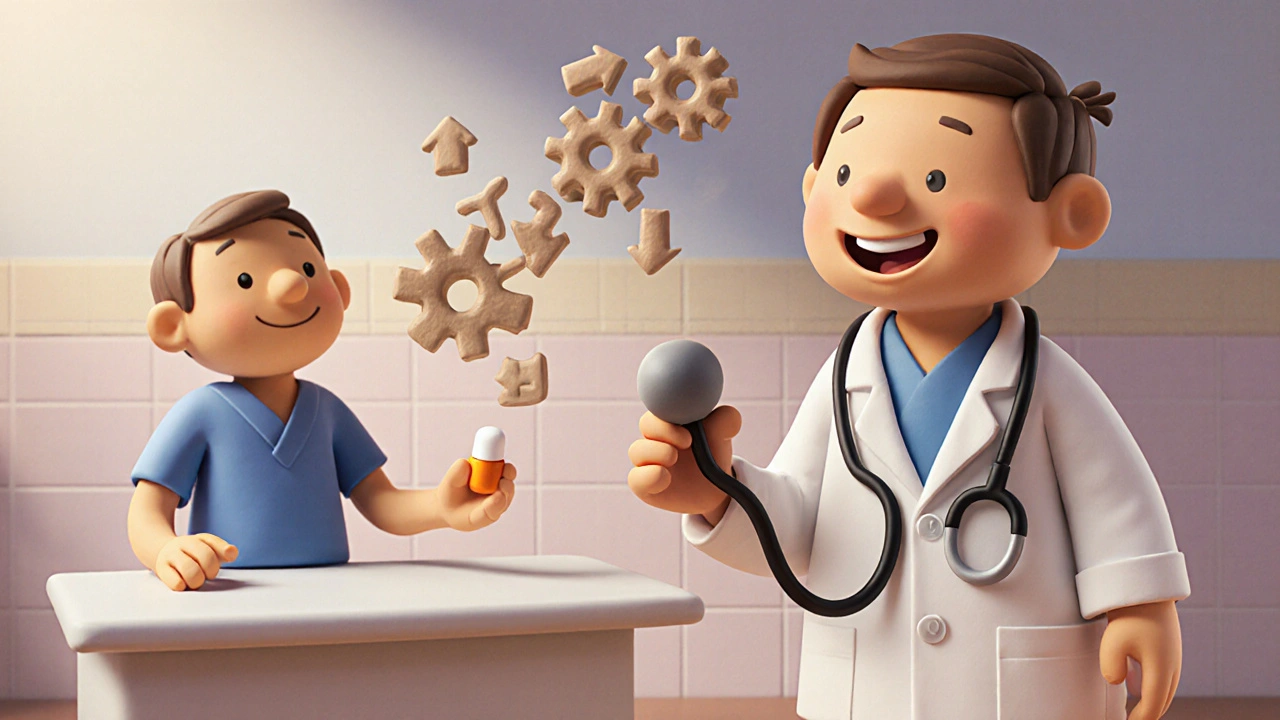Antiarrhythmic Drug Selection Tool
Patient Profile Assessment
Answer these questions to identify suitable alternatives to Amiodarone based on your condition and health factors.
Quick Summary
- Amiodarone is very effective for both atrial and ventricular arrhythmias but carries a high long‑term toxicity risk.
- Sotalol offers oral convenience with a shorter half‑life, yet can provoke torsades de pointes.
- Dofetilide is safe for heart‑failure patients but requires strict renal dosing and hospital initiation.
- Propafenone and Flecainide are strong “pill‑in‑the‑ pocket” options for recent‑onset AF but are contraindicated in structural heart disease.
- Mexiletine is the go‑to oral version of lidocaine, useful for ventricular ectopy when other drugs fail.
What Is Amiodarone (Cordarone)?
Amiodarone is a class III antiarrhythmic medication that prolongs the cardiac action potential and refractoriness. It’s sold under the brand name Cordarone in many countries. Physicians often reach for it when other drugs can’t control atrial fibrillation (AF) or ventricular tachycardia (VT). The drug’s unique chemistry lets it work on multiple ion channels (K+, Na+, Ca2+), which explains its broad spectrum.
The flip side? Amiodarone sticks around. Its half‑life can exceed 100 days, meaning side effects linger long after you stop taking it. Common concerns include thyroid dysfunction, pulmonary fibrosis, liver enzyme elevation, and eye deposits.
Why Compare Alternatives?
If you or a loved one are prescribed Cordarone, the question isn’t just “Does it work?” but also “Is there a safer, equally effective option?” Modern guidelines encourage tailoring therapy to the patient’s comorbidities, age, and lifestyle. That’s why we line up the most frequently used alternatives and weigh them side‑by‑side.

Top Alternative Antiarrhythmics
Below are the five drugs clinicians consider when looking for an Amiodarone alternatives. Each belongs to a different class or has a distinct safety profile.
Sotalol - Class III & Beta‑Blocker
Sotalol blends a beta‑blocking effect with potassium‑channel blockade. It’s taken orally, usually twice daily, and has a half‑life of about 12 hours, so it clears relatively fast compared with Amiodarone.
Strengths: good for patients needing rate control and rhythm control together; less organ toxicity. Weaknesses: can trigger torsades de pointes, especially in patients with low potassium or prolonged QT.
Dofetilide - Pure Class III
Dofetilide targets the rapid component of the delayed rectifier potassium current (IKr). It’s only available in oral form and must be started in a monitored setting because of the same torsades risk as Sotalol.
Strengths: safe in heart‑failure patients; works well for both AF and flutter. Weaknesses: dose must be adjusted for renal function; requires hospital admission for initiation.
Propafenone - Class IC
Propafenone blocks sodium channels and has mild beta‑blocking activity. It’s popular for “pill‑in‑the‑ pocket” conversion of recent‑onset AF.
Strengths: rapid onset, good for patients without structural heart disease. Weaknesses: contraindicated in coronary artery disease, can cause QRS widening.
Flecainide - Class IC
Flecainide is a potent sodium‑channel blocker, also used for “pill‑in‑the‑ pocket” strategy and for preventing recurrence after cardioversion.
Strengths: very effective for AF in structurally normal hearts. Weaknesses: can be pro‑arrhythmic in patients with left‑ventricular dysfunction; requires careful ECG monitoring.
Mexiletine - Class IB (Oral Lidocaine)
Mexiletine is the oral counterpart to IV lidocaine. It shortens the action potential duration, making it useful for ventricular ectopy and certain types of VT.
Strengths: short half‑life (≈12 h), good for patients who can’t tolerate longer‑acting drugs. Weaknesses: less effective for atrial arrhythmias; can cause neurologic side effects (tremor, dizziness).
Side‑Effect Snapshot
All antiarrhythmics have trade‑offs. The table below puts the most relevant safety data next to efficacy clues.
| Drug | Class | Typical Route | Half‑Life | Main Indications | Key Side Effects |
|---|---|---|---|---|---|
| Amiodarone (Cordarone) | III (multi‑channel) | PO/IV | 30-110 days | AF, VT, VF | Thyroid, pulmonary fibrosis, liver, skin, ocular deposits |
| Sotalol | III + β‑blocker | PO | 12-15 h | AF, ventricular ectopy | Torsades, bradycardia, β‑blockade effects |
| Dofetilide | III | PO | 10-20 h | AF, flutter | Torsades, renal dosing concerns |
| Propafenone | IC | PO | 5-10 h | Recent‑onset AF | QRS widening, heart failure contraindication |
| Flecainide | IC | PO | 12-20 h | AF, SVT | Pro‑arrhythmia in structural disease |
| Mexiletine | IB | PO | 11-15 h | Ventricular ectopy, LQT3 | Neurologic (tremor, dizziness), GI upset |
How to Choose the Right Drug for You
The decision isn’t purely about numbers; it’s a conversation between you, your cardiologist, and your overall health picture. Below is a practical flow you can run through during a clinic visit.
- Identify the primary arrhythmia (AF vs VT vs premature beats).
- Check for structural heart disease, heart‑failure status, and kidney function.
- Ask about lifestyle preferences: do you need an oral daily pill, or can you tolerate occasional IV loading?
- Review past drug tolerability-any history of thyroid problems, lung disease, or arrhythmia‑induced fainting?
- Match the profile to the table above. If organ toxicity is a red flag, steer away from Amiodarone. If you have normal heart structure but need rapid conversion, consider Propafenone or Flecainide.
- Agree on a monitoring plan: ECG, labs (TSH, LFT, creatinine), and symptom logs.
Remember, even the best‑matched drug can cause side effects. Early detection-through routine labs or symptom awareness-keeps complications manageable.

Practical Tips for Managing Amiodarone Therapy
If you end up on Cordarone, here are three steps that make long‑term use safer:
- Baseline labs: Get thyroid‑stimulating hormone (TSH), liver enzymes, and a chest X‑ray before starting.
- Regular follow‑up: Check TSH every 6 months, liver function every 3 months, and a pulmonary function test annually.
- Watch for symptoms: New shortness of breath, skin discoloration, or visual changes should trigger an immediate doctor call.
When Switching Away From Amiodarone
Switching isn’t as simple as stopping a pill because the drug persists in tissue for months. A typical taper looks like this:
- Reduce dose by 25 % every 4-6 weeks while monitoring ECG.
- Introduce the chosen alternative (e.g., Dofetilide) at a low dose once the amiodarone trough is < 2 mg/L (if you have blood level testing).
- Continue lab surveillance for the new drug’s specific risks.
Always have a cardiologist guide the taper-premature discontinuation can trigger rebound arrhythmias.
Bottom Line
Amiodarone remains a powerhouse for stubborn arrhythmias, but its long‑term toxicity profile pushes many clinicians to consider alternatives first. Sotalol and Dofetilide give you rhythm control with shorter exposure, while Propafenone and Flecainide excel in patients with healthy hearts who need quick conversion. Mexiletine fills the niche for ventricular ectopy when other drugs fall short.
Use the comparison table, weigh your personal health factors, and have an open dialogue with your heart team. The right choice balances effectiveness with safety-so you can stay active without worrying about hidden side effects.
Can I stop Amiodarone abruptly?
No. Because Amiodarone stays in the body for weeks, stopping suddenly can cause a rebound of the arrhythmia and other withdrawal effects. A slow taper under medical supervision is essential.
Is Sotalol safer for patients with thyroid disease?
Yes. Sotalol does not affect thyroid function, making it a better option for those with pre‑existing hypo‑ or hyper‑thyroidism, provided they have normal QT intervals.
When is Dofetilide preferred over other class III drugs?
Dofetilide is favored in patients with heart failure or reduced ejection fraction, because it does not have the negative inotropic effect seen with some other antiarrhythmics.
Can I use Propafenone if I have hypertension?
Propafenone’s mild beta‑blocking action can actually help lower blood pressure, but it should be avoided if you have coronary artery disease or left‑ventricular dysfunction.
What monitoring is required for Mexiletine?
Baseline liver function tests and periodic neurologic exams are recommended, as Mexiletine can cause hepatic irritation and tremor.


Diane Larson
October 23, 2025 AT 23:23I've been following the debate around amiodarone for years, and the biggest takeaway is that you have to match the drug to the patient's overall health picture. If you have any thyroid or lung issues, steering clear of Cordarone early on can save a lot of trouble down the road. For someone with normal cardiac structure but frequent AF episodes, a pill‑in‑the‑pocket approach with propafenone or flecainide often works wonders. On the other hand, if you’re dealing with refractory ventricular tachycardia, amiodarone’s broad‑spectrum action is hard to beat despite the monitoring burden. The key is open communication with your cardiologist and a solid lab‑monitoring plan.
Michael Kusold
October 23, 2025 AT 23:33yeah, the table is super helpful. i wish docs would just hand out the flowchart in the waiting room. also, don't forget to ask about any past skin rashes before starting amiodarone.
Jeremy Lysinger
October 23, 2025 AT 23:48Bottom line: pick a drug that fits your lifestyle and stick to a monitoring schedule. No one wants surprise side effects.
Nelson De Pena
October 23, 2025 AT 23:58The pharmacokinetics of amiodarone are uniquely problematic because of its lipophilicity. Its half‑life can exceed three months, which necessitates prolonged surveillance of thyroid and hepatic panels. Conversely, agents like sotalol or dofetilide clear much faster, simplifying dose adjustments.
Wilson Roberto
October 24, 2025 AT 00:12When you consider the broader philosophical implications of medication choice, it becomes clear that we're not just treating an arrhythmia but also shaping a patient's future trajectory. The body is an ecosystem; introducing a drug like amiodarone is akin to inserting a new keystone species. It can create ripple effects that reach far beyond the heart, influencing endocrine balance, pulmonary health, and even psychological wellbeing. That said, the same drug’s versatility offers a unique chance to restore stability in chaotic electrical activity, which can be a profound gift. We must weigh the potential for long‑term toxicity against the immediate need for rhythm control, remembering that each patient’s tolerance is a personal narrative. In practice, this means a thorough baseline evaluation, clear communication of risks, and shared decision‑making. It also highlights the importance of alternative pathways-whether that’s lifestyle modification, catheter ablation, or a different antiarrhythmic. Ultimately, the goal is to empower patients to live fully, not merely survive.
Narasimha Murthy
October 24, 2025 AT 00:22While the article paints a balanced picture, it underestimates the practical challenges of initiating dofetilide in real‑world settings. Hospital admission for a 24‑hour monitoring period is often a logistical and financial burden that many clinics cannot meet. Moreover, the purported safety in heart‑failure patients does not translate seamlessly across diverse populations, especially those with borderline renal function. Therefore, the recommendation to favor dofetilide over amiodarone should be tempered with a realistic appraisal of resource constraints.
Samantha Vondrum
October 24, 2025 AT 00:37Thank you for such a comprehensive guide; it will be invaluable for both patients and clinicians alike. The clear breakdown of each medication’s pros and cons helps demystify a complex topic. I particularly appreciate the emphasis on regular lab monitoring, which is often overlooked. Your inclusion of practical tips for tapering amiodarone is spot‑on and will aid many in avoiding rebound arrhythmias. Keep up the excellent work! 🙂
Kelvin Egbuzie
October 24, 2025 AT 00:47Oh great, another post telling us to trust the “medical establishment” while ignoring the hidden pharma agendas. 🤔 Sure, just pop that pricey drug and hope the side effects don’t turn you into a walking X‑ray. Remember, if they’re not telling you it can mess with your DNA, they’re lying.
Katherine Collins
October 24, 2025 AT 00:55Sounds good.
Taylor Nation
October 24, 2025 AT 01:05Agreed, especially when the patient’s schedule can’t accommodate frequent lab visits. It's essential to ask if the doctor can provide a clear, step‑by‑step plan.
Nathan S. Han
October 24, 2025 AT 01:25Choosing the right antiarrhythmic has become a nuanced decision, integrating pharmacology, patient comorbidities, and lifestyle considerations. First, one must assess the primary arrhythmic substrate-whether it is atrial fibrillation, ventricular tachycardia, or premature beats. Next, the presence of structural heart disease dictates avoidance of class IC agents like flecainide and propafenone due to pro‑arrhythmic risk. In patients with preserved left ventricular function and recent‑onset AF, a rapid‑acting pill‑in‑the‑pocket strategy can be both convenient and effective, making propafenone or flecainide attractive options. However, those with coronary artery disease or reduced ejection fraction should be steered toward class III agents, with careful selection between amiodarone, sotalol, or dofetilide based on organ function. Amiodarone remains the powerhouse for refractory cases, yet its ultra‑long half‑life mandates vigilant monitoring for thyroid, hepatic, and pulmonary toxicity. Sotalol offers a shorter half‑life but carries a substantial torsades risk, particularly in the context of hypokalemia or prolonged QT intervals. Dofetilide, while safe in heart‑failure patients, requires dose adjustment for renal impairment and mandatory inpatient initiation. For ventricular ectopy, mexiletine provides an oral alternative to IV lidocaine, though clinicians must watch for neurologic side effects such as tremor. The decision matrix also incorporates patient preferences regarding dosing frequency, potential side effects, and willingness to undergo regular laboratory testing. Ultimately, a shared decision‑making process, supported by evidence‑based guidelines, ensures that the treatment aligns with both clinical efficacy and patient quality of life. Regular follow‑up with ECGs and targeted labs is indispensable, regardless of the chosen agent, to detect early signs of toxicity. Moreover, clinicians should remain vigilant for drug‑drug interactions, especially in polypharmacy scenarios common among older adults. Finally, in cases where pharmacologic therapy fails or is contraindicated, electrophysiological interventions like catheter ablation may provide a curative pathway, underscoring the importance of a comprehensive, individualized treatment plan.
Shermaine Davis
October 24, 2025 AT 01:35This is a solid overview, especially for patients who might be overwhelmed by all the medical jargon. It breaks down the key points in a way that’s easy to understand.
Selina M
October 24, 2025 AT 01:48Great summary, love the clear tables and tips. Makes the choices less confusing and more doable.
tatiana anadrade paguay
October 24, 2025 AT 01:58Thanks for the practical advice; I’ll definitely bring this up at my next appointment. It’s reassuring to see a balanced view of risk and benefit.
Nicholai Battistino
October 24, 2025 AT 02:13Concise and clear.